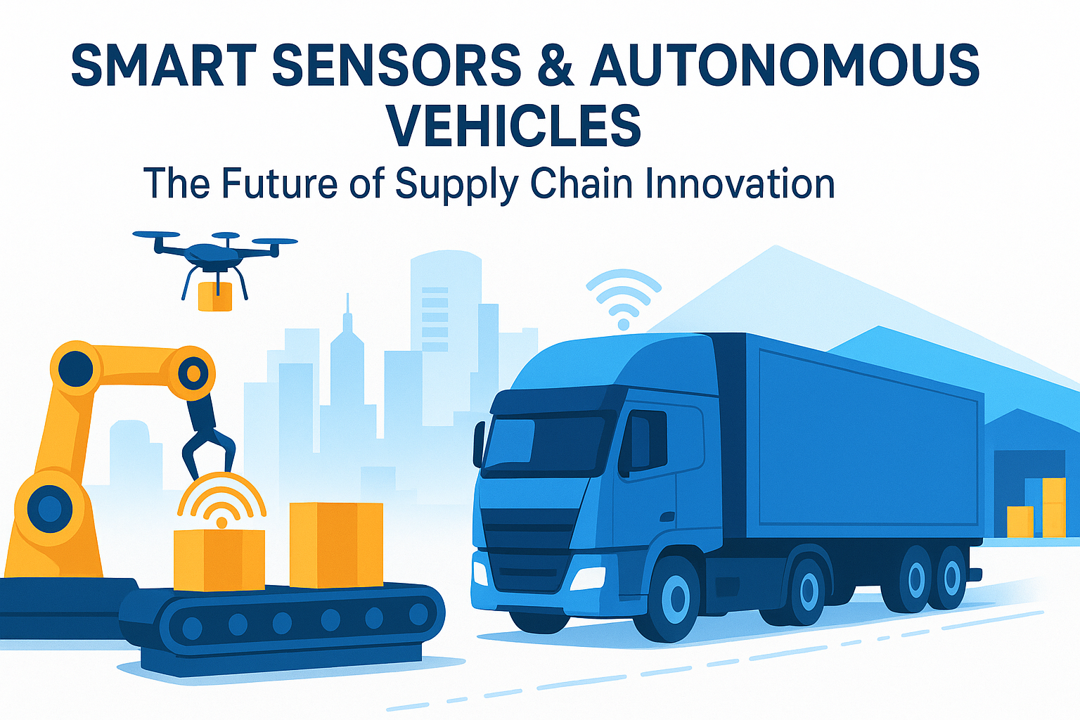
Post by : Meena Rani
The global supply chain industry is undergoing a massive transformation. What was once a network of trucks, ships, warehouses, and paperwork is now turning into a digital, automated ecosystem powered by smart technologies. Among the most groundbreaking innovations, smart sensors and autonomous vehicles stand out as the new heartbeat of modern supply chains.
These technologies are reshaping logistics by offering real-time visibility, predictive insights, and efficient delivery systems. For businesses, the benefits include cost reduction, fewer delays, and stronger customer satisfaction. For consumers, it means faster and more reliable deliveries.
Smart sensors are tiny, connected devices that capture and transmit data about products, vehicles, or warehouse environments. Integrated with the Internet of Things (IoT), they provide supply chain managers with real-time insights that were unimaginable a decade ago.
Reduced Errors & Delays: Real-time tracking minimizes the risk of lost or misplaced shipments.
Predictive Maintenance: Vehicle sensors detect wear and tear early, preventing costly breakdowns.
Improved Transparency: Companies can track products from factory to consumer, increasing trust.
For example, cold-chain logistics companies now rely heavily on smart sensors to ensure that vaccines and perishable foods remain at the correct temperature throughout transit.
Autonomous vehicles—ranging from self-driving trucks to warehouse robots—are redefining how goods are moved, stored, and delivered. While the technology is still developing, it has already made significant inroads in supply chains worldwide.
Lower Operational Costs: Autonomous fleets reduce labor and fuel expenses.
Faster Delivery Times: Automation shortens delivery cycles, especially for e-commerce.
Improved Safety: AI-driven navigation lowers the risk of human error accidents.
A striking example is Amazon’s Prime Air drone delivery project, which aims to deliver lightweight packages in minutes—a bold step toward next-generation logistics.
While each technology is powerful on its own, their true potential emerges when combined. Smart sensors feed autonomous vehicles with live data, helping them make better decisions in real time.
Retail Giants: Walmart and Amazon are integrating autonomous trucks and drones with sensor data to achieve faster, cheaper deliveries.
Pharmaceutical Logistics: Cold-chain shipments are tracked by smart sensors while autonomous vehicles ensure speed and precision in critical deliveries.
This seamless integration is creating a supply chain ecosystem that is both intelligent and autonomous.
High Initial Investment: Deploying smart sensors and autonomous vehicles requires significant upfront costs.
Connectivity Issues: Sensors depend on strong 5G or IoT networks, which are not available everywhere.
Scalability: Large-scale implementation across global supply chains remains complex.
Legal Framework: Self-driving vehicles still face regulatory uncertainty in many countries.
Data Privacy: Sensors generate massive amounts of data, raising concerns about how it is stored and used.
Public Trust: Acceptance of driverless trucks and drone deliveries is still evolving.
Overcoming these barriers will require collaboration between governments, tech companies, and logistics providers.
AI & Machine Learning: Improve decision-making by analyzing sensor data for demand forecasting and inventory optimization.
Blockchain: Provides transparency and trust by creating tamper-proof records of product movement.
5G Networks: Enable ultra-fast communication between vehicles, sensors, and supply chain systems.
For Businesses: Reduced logistics costs, improved sustainability, and streamlined operations.
For Consumers: Faster deliveries, real-time package tracking, and higher product safety.
Industry experts believe that by 2030, fully automated supply chains—powered by sensors, AI, and autonomous vehicles—will become the new standard.
Smart sensors and autonomous vehicles are no longer futuristic ideas—they are here, actively transforming supply chains. Together, they bring speed, accuracy, and intelligence to global logistics. While challenges around regulation, cost, and infrastructure remain, the direction is clear: supply chains of tomorrow will be smart, autonomous, and highly efficient.
For businesses that embrace these technologies today, the reward is a competitive edge in an increasingly digital-first economy.
SmartSensors #AutonomousVehicles #SupplyChainInnovation #LogisticsTechnology #SmartLogistics #DigitalSupplyChain #AIinLogistics #IoTinSupplyChain #FutureOfSupplyChains #AutonomousDelivery










Advances in Aerospace Technology and Commercial Aviation Recovery
Insights into breakthrough aerospace technologies and commercial aviation’s recovery amid 2025 chall

Defense Modernization and Strategic Spending Trends
Explore key trends in global defense modernization and strategic military spending shaping 2025 secu

Tens of Thousands Protest in Serbia on Anniversary of Deadly Roof Collapse
Tens of thousands in Novi Sad mark a year since a deadly station roof collapse that killed 16, prote

Canada PM Carney Apologizes to Trump Over Controversial Reagan Anti-Tariff Ad
Canadian PM Mark Carney apologized to President Trump over an Ontario anti-tariff ad quoting Reagan,

The ad that stirred a hornets nest, and made Canadian PM Carney say sorry to Trump
Canadian PM Mark Carney apologizes to US President Trump after a tariff-related ad causes diplomatic

Bengaluru-Mumbai Superfast Train Approved After 30-Year Wait
Railways approves new superfast train connecting Bengaluru and Mumbai, ending a 30-year demand, easi